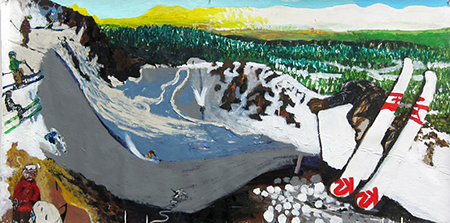
Continuing through April 5, 2014
A little more than 10 years ago, MoCA presented an installation called "Jungle Island" at the Geffen; it was formed out of a collection of ferns, palms, and other tropical-style plants and trees, along with a dirt and wood chip floor. In the midst of this artificial jungle, four topographically detailed marble sculptures were interspersed, each depicting a different L.A.-area highway interchange and its neighboring environs. One of the junctions near downtown (I want to say it was the 110 and the 5, but apparently there was no such freeway piece) stuck with me most. In fact, nearly every time I approach the tunnels that will spit me out onto to the 5, I think of Yutaka Sone's marble counterpart. It's a cold yet somehow quirky form of immortalization that, if nothing else, forces you to take in the urban jungle of L.A. with a new lens, one with maybe even a little bit of wonder. With the freeway interchanges not only reduced down to essentially miniature scale but also with their humanity and chaos buffed down into invisibility, we're given an opportunity to zoom out to the macro, let life reflect back on art, and perhaps gain a healthy sense of our smallness in the greater world.
In addition to memorializing the urban, Sone often takes forms from nature as his subject — palms, banana trees, snowflakes, and the aforementioned jungle. At the behest of local art legend and sage Paul McCarthy, Sone was introduced to Benjamin Weissman, a writer, painter, and ski buff who shared with Sone a connoisseurship of all things outdoors. They allegedly met atop the slopes of Mammoth Mountain, an infamous northern California ski spot where nature does its best to accommodate the unruly masses of weekend warriors, who descend upon it every winter and early spring. In 2007, Weissman and Sone began collaborating on sculpture and painting, the latter of which are expressive visions of skiing Mammoth that skew heavily towards the goofy, a bracing departure from Sone's cool, white marble urban landscapes (Sone also makes paintings on his own, and a 2005 work, titled "Gold Rush," loosely depicts a bird's eye view of two skiers on a chairlift from the knees to the skis, with some trees below. The image suggests that the tone and sensibility of the collaborative paintings have been set by Sone.) Skiers perch atop Mammoth's Cornice Bowl; they leave a trail of cartoonishly stylized snowflakes in their wake; and carve out a rest spot amid the trees to take a toke break, where the smoke rises in splotches of pink and green.
But the paintings here are the appetizers, or more precisely the tapas, for the main course: an indoor animatronic snow mountain, replete with a chair lift and accompanied by a cast of ski character sculptures. Though one can make wild guesses how this wonderland will turn out, it's nearly impossible to avoid McCarthy's shadow — he of true animatronic madness. Whereas McCarthy mines the darker (if not darkest) underbellies of the family, the Wild West, Disney, and other mythic pop cultural icons, Sone and Weissman stay on the light-hearted end of the spectrum, indulging in the hedonistic pursuits of surf and snow (the latter of which reminds me of the California trope of pursuing both — skiing and surfing — in the same day). Weissman, speaking of being on the mountain, describes being "deep inside the sensorial-spiritual ineffable," which reflects an intent to reconciling the hedonistic with the spiritual, a goal I thoroughly endorse. How does this translate to art? It inevitably harkens back to Matisse's soothing armchair, which is hardly where McCarthy comes to rest. For many artists that armchair is a metaphor of limited ambition, or worse still, a certain complicity that excludes the larger world landscape.
One has to assume that the bottom-line conceit of "What Every Snowflake Knows in Its Heart" is its novelty: a mountain within a museum. The ambition of it has a Chris Burden-esque scale quotient, together with (and based on the established sensibility of the duo's painting and Sone's previous body of sculpture) a McCarthy-esque grunge-factor. Of course, anticipating this grand gesture's idiosyncrasies, in a preview such as this that is written in advance of the completed installation, is a matter of speculation. Sone's track record is ample enough to instill faith that it will be a worthy display. As for whether it's the right time, or a suitable zeitgeist for such a display, it's way too early to tell.
Published courtesy of ArtSceneCal ©2014
